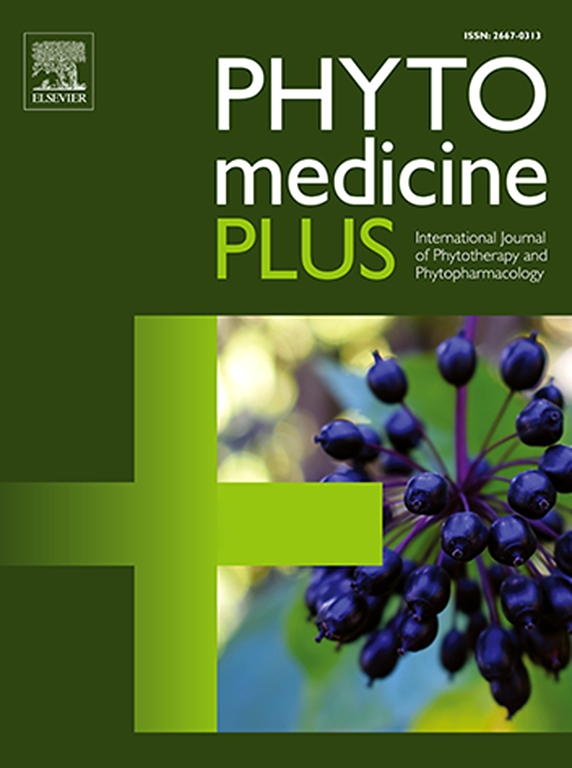Ethnopharmocology, phytochemistry and pharmacology of the genus Orthosiphon: A review
Q3 Pharmacology, Toxicology and Pharmaceutics
引用次数: 0
Abstract
Background
Plants of the genus Orthosiphon (Lamiaceae) have been widely employed in traditional and ethnic medicines for the treatment of various diseases, including diabetes, kidney stones, edema, rheumatism, hepatitis, hypertension, and urinary tract disorders.
Purpose
This review summarized the research progresses in botany, traditional uses, phytochemistry, and pharmacological activities on plants of the genus Orthosiphon. Additionally, this review described the shortcomings of studies on these species, thus serving as the basis of further researches and development of these traditional herbal medicines.
Method
Orthosiphon-related information was collected from the online databases, such as Google Scholar, SciFinder, Web of Science, Elsevier, PubMed and China Knowledge Resource Integrated (CNKI).
Results
Plants of the genus Orthosiphon are widely distributed in African, Australia, South Asian, and Southeast Asian, and in China. Phytochemical investigations on Orthosiphon species have revealed the presence of various compounds, mainly including phenolic acids, flavonoids, diterpenoids, triterpenoids, sesquiterpenoids, and chromenes. Previous reports have demonstrated the diverse pharmacological properties of extracts and constituents derived from Orthosiphon, such as anti-cancer, anti-diabetic, anti-inflammatory, antioxidant, hepatoprotective, analgesic, and nephroprotective effects. However, previous researches on this genus were somewhat limited and skewed towards a few species, with a particular emphasis on O. aristatus, O. wulfenioides, O. thymiflorus and O. rubicundus (D. Don) Benth, which might be attributed to the ethnopharmacological background, geographical constraints, and the distribution of these species. In the future, more investigations on other species of the genus Orthosiphon are needed.
Conclusion
This study provided a comprehensive overview of the ethnopharmacological, phytochemical, and pharmacological progresses related to the genus of Orthosiphon. Despite substantial bias in attention among various species of the genus Orthosiphon, its potential as health food and therapeutic agents is evident. The genus is an underexplored source of bioactive compounds with potential in various therapeutic areas. This review laid the groundwork for further investigation and development of these traditional herbal remedies.

正虹吸属植物的民族药理学、植物化学和药理学研究进展
正虹吸属植物(Lamiaceae)在传统和民族医药中被广泛用于治疗各种疾病,包括糖尿病、肾结石、水肿、风湿病、肝炎、高血压和泌尿系统疾病。目的综述了正虹吸管属植物在植物学、传统用途、植物化学和药理活性方面的研究进展。此外,本文还介绍了这些物种研究的不足之处,从而为进一步研究和开发这些传统草药提供基础。方法从谷歌Scholar、SciFinder、Web of Science、Elsevier、PubMed、中国知网(CNKI)等在线数据库中收集thosiphon相关信息。结果正虹吸属植物广泛分布于非洲、澳大利亚、南亚、东南亚及中国。植物化学研究表明,正虹吸属植物含有多种化合物,主要包括酚酸、类黄酮、二萜类、三萜类、倍半萜类和铬。以前的报道已经证明了正虹吸管提取物和成分的多种药理特性,如抗癌、抗糖尿病、抗炎、抗氧化、保肝、镇痛和肾保护作用。然而,以往对该属植物的研究存在一定的局限性和偏向,主要集中于O. aristatus、O. wulfenioides、O. thymiflorus和O. rubicundus (D. Don) Benth,这可能与这些物种的民族药理学背景、地理限制和分布有关。今后还需要对正虹吸属的其他种类进行更多的研究。结论本研究综述了正虹吸属植物的民族药理学、植物化学和药理研究进展。尽管人们对正虹吸属各种植物的关注存在很大偏差,但其作为保健食品和治疗剂的潜力是显而易见的。该属是一种未被充分开发的生物活性化合物来源,在各种治疗领域具有潜力。这一综述为进一步研究和开发这些传统草药奠定了基础。
本文章由计算机程序翻译,如有差异,请以英文原文为准。
求助全文
约1分钟内获得全文
求助全文
来源期刊

Phytomedicine Plus
Medicine-Complementary and Alternative Medicine
CiteScore
3.70
自引率
0.00%
发文量
178
审稿时长
81 days
期刊介绍:
 求助内容:
求助内容: 应助结果提醒方式:
应助结果提醒方式:


